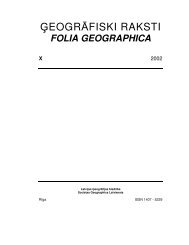eogrÄfiski raksti folia geographica xii - Ä¢eogrÄfijas un Zemes zinÄtņu ...
eogrÄfiski raksti folia geographica xii - Ä¢eogrÄfijas un Zemes zinÄtņu ...
eogrÄfiski raksti folia geographica xii - Ä¢eogrÄfijas un Zemes zinÄtņu ...
Create successful ePaper yourself
Turn your PDF publications into a flip-book with our unique Google optimized e-Paper software.
General information (Riga)<br />
21<br />
NATURE RESEARCH<br />
Table 2<br />
Data<br />
Day-length<br />
Jan Feb Mar Apr May J<strong>un</strong> Jul Aug Sep Oct Nov Dec Year<br />
(hours,<br />
minutes)<br />
Height of<br />
7:21 9:24 11:43 14:13 16:31 17:47 16:40 14:40 12:38 10:00 7:28 6:45<br />
midday S<strong>un</strong><br />
(degrees)<br />
11.8 19.9 30.8 42.7 51.8 56.3 54.6 47.2 36.1 24.6 14.6 9.7<br />
Clear skies<br />
(days) *<br />
1 1.4 3.2 2.0 3.3 1.8 2.7 1.7 1.8 0.7 0.6 0.6 21<br />
Cloudy days* 20.6 17.0 12.5 12.9 10.2 11.0 12.0 10.8 10.9 16.9 22.2 21.5 178<br />
S<strong>un</strong>shine<br />
duration<br />
(hours)<br />
Relative<br />
36 61 140 197 268 282 276 235 166 91 35 25 1812<br />
s<strong>un</strong>shine<br />
duration (%)<br />
Incoming solar<br />
18 25 42 49 56 57 56 54 48 32 17 14 44<br />
radiation at<br />
surface<br />
(MJ/m²)<br />
41.4 98.4 246.7 379.1 568.9 549.7 564.5 460.3 262.8 129.2 48.8 28.8 3379<br />
* After Reference book on the Climate of the USSR, issue 5, part 4 [1969]; clear skies are reported as 0-2 <strong>un</strong>its of total cloudiness<br />
and cloudy days as 8-10 <strong>un</strong>its of total cloudiness.<br />
The rest data after Reference book on the Climate of the USSR, issue 5, part 1 [1966]. The relative s<strong>un</strong>shine duration is the recoded<br />
duration expressed as percentage of the longest possible duration of that specific time.<br />
In the beginning and the end of the period of negative net radiation (in other words –<br />
winter) the day-length in the central part of Latvia is ca 9 hours and the height of midday S<strong>un</strong> is<br />
aro<strong>un</strong>d 20º (at winter solstice – December 21 – these parameters are only 6.5 hours and 9.5º).<br />
Winter is also remarkable for the highest number of cloudy days and the least number of clear<br />
days, so that the actual duration of s<strong>un</strong>shine shortens to 15-20% of the maximum s<strong>un</strong>shine.<br />
Consequently, the intensity of solar energy influx is quite small; moreover the cloud cover<br />
reduces the long-wave radiation emitted to the space and the reflected radiation. As a result,<br />
during four months the mean diurnal sum of Rnt is only slightly below zero, and for some hours<br />
in the midday usually is above zero.<br />
The described state of landscape is typical of mid-winter, which lasts from aro<strong>un</strong>d a<br />
month before to a month after the winter solstice. The previous phase or pre-winter still shows<br />
a small decrease of Rnt, but during late winter an increase of Rnt is clearly seen (Figure 2).Yet,<br />
the division of Latvia’s winter into phases by decrease, minimum and growth of Rnt is of<br />
secondary importance, because the influence of atmosphere circulation commonly makes the<br />
average differences within one phase larger than interphase differences, and, besides, the lowest<br />
diurnal radiation Rnt has been observed in mid-, pre- and late winter (Table 1).<br />
Of much greater heterogenity is the two times longer period of positive net radiation,<br />
which encompasses the customary spring, summer and autumn seasons. This period consists of<br />
a phase of stable Rnt growth (second half of February to first half of May, with a steeper growth<br />
from the middle of March till the middle of April) and stable decrease (end of July to end of<br />
October, with a steeper fall from the beginning of August till the end of September), and the<br />
culminant phase (yearly maximum) between the two mentioned phases.<br />
Although generally viewed, the annual course of Rnt follows the curves of day-length and<br />
the height of mid-day s<strong>un</strong>, during the culminant phase, from the first half of May through the<br />
end of July, such relationship is not observed. In the beginning and at the end of the phase, the<br />
height of midday S<strong>un</strong> is 51.5º and the day-length 16.5 hours, but in the middle of period<br />
(summer solstice) these increase to 56.5º and almost 18 hours. However, during the entire phase<br />
the s<strong>un</strong>shine duration and also Rnt stay invariably at a high level. The latter surpasses<br />
1.2 MJ/m²·hour 3-5 hours per day on average (Figure 1). An explanation behind this is that also<br />
in summer the radiation pattern strongly depends on the changing cloud cover determined by<br />
atmosphere circulation. However, the Rnt culminant phase (as distinct from the period with<br />
negative Rnt) coincides with the yearly minimum of cloudiness and thus with the phase of<br />
maximum potential s<strong>un</strong>shine (Table 2).

















